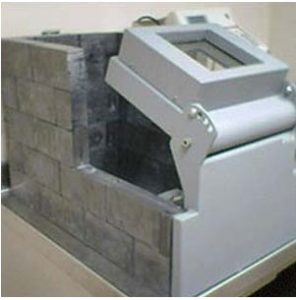The field of nuclear medicine is growing rapidly with innovations in technology, diagnostic procedures, and therapeutic purposes. Variety of workplaces including hospitals, universities, and research facilities are all involved in producing, researching, and administering radiopharmaceuticals. With the increase and widespread use of nuclear medicine, the demand for shielding increases as well. There are many shielding products geared towards the nuclear medicine industry.
Below are some of the common shielding products that would be used in a lab or clinic setting.
Lead and Tungsten Pigs

Commonly used products are tungsten vial shields for the administering of radioisotopes; while tungsten or lead storage containers are often referred to as “pigs”.
Solid tungsten is a very commonly used material because it is durable and has slightly better gamma radiation attenuation than lead. The drawback of tungsten is that it is significantly more expensive than the lead. Solid tungsten can also be made into syringe shields and vial transport containers.
Lead pigs can be susceptible to being damaged or dented over time but is often more cost effective than tungsten. The pigs can be encased in metal or plastic to help the pig hold its form over time and to reduce any potential lead exposure. Pictured is a lead pig that provides ¾” of solid lead shielding.
For both lead and tungsten pigs, features such as threaded lids, latches for the lid, painting and custom designed sizes are very possible.
Lead Lined Cabinets and Storage Containers
 A big product used by the nuclear medicine industry is lead lined furniture. These are specially built cabinets or containers that allow for the storage of radioactive waste, isotopes, radiopharmaceuticals, and other materials. The shielding in these containers can vary from 1/16” up to over 2” of shielding. The lead inside the cabinet is fully enclosed with steel and is made by either placing sheet lead or casting lead inside steel cabinet.
A big product used by the nuclear medicine industry is lead lined furniture. These are specially built cabinets or containers that allow for the storage of radioactive waste, isotopes, radiopharmaceuticals, and other materials. The shielding in these containers can vary from 1/16” up to over 2” of shielding. The lead inside the cabinet is fully enclosed with steel and is made by either placing sheet lead or casting lead inside steel cabinet.
Lead lined storage and waste containers are made in a similar manner. These products are commonly found in hospitals and labs as they allow for easy access to radioisotopes, while protecting people from any radiation exposure. Specially designed doors and openings are used to eliminate the risk of radiation leakage.
Lead Brick Caves and L Blocks

For doing lab work with radioisotopes, it is important to keep the lab technicians’ safety in mind. Lead brick caves are constructed from standard lead brick and can be painted. For easy set up and customize workspace, while providing adequate protection from radiation, lead bricks can be a very useful shielding to have around the lab.
L-Blocks can have up to 2” of lead shielding and usually include a lead glass window that can include up to 8” of glass. This provides radiation protection to the front and face of workers while allowing them to see what they are working on. Generally, L-Blocks are metal fabrications lined with lead.
Custom Designs
Often a standard off the shelf product does not work in a lab setting. All the products mentioned above can be customized to meet size, shielding and other special design considerations. As a materials expert and shielding designers at MarShield, we have worked with many customers in designing custom shielding that fits best for them. If you would like to find out more information about what shielding solutions MarShield can come up with, you can find more information from the MarShield website or you can contact MarShield directly, and we will help you find the best radiation shielding solution for you.
Explore our Nuclear Medicine Shielding Products
MarShield Custom Radiation Shielding Products provides radiation shielding solutions for the Medical and Nuclear industries and is a division of Mars Metal Company. Contact us today to discuss your unique radiation shielding needs.



